Click here for the index of this series
You’ll find the entrance to the British Camp Trail just across the parking lot from the Visitors Center. Be sure to pick up a Park map while you’re there.
The image on the left shows how the Enoree River divides the Park into north and south sections. Keep that division in mind as you plan your visit. There’s plenty to see on both sides of the River, so budget time accordingly.
In fact, I found it impossible to cover both sections of the Park during one visit. Had to come back two more times. But your mileage may vary. Not everyone reads every word on every informational sign. Or stops so frequently to enjoy the scenery. Or walks so slowly. Or has as much time to devote to State Park visits!
 A word about the trails at Musgrove Mill. They’re clear, and well maintained. But I wouldn’t recommend them for travel in a scooter or some other sort of wheeled vehicle.
A word about the trails at Musgrove Mill. They’re clear, and well maintained. But I wouldn’t recommend them for travel in a scooter or some other sort of wheeled vehicle.
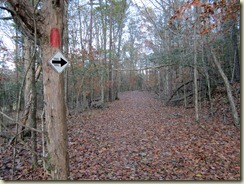 Here and there it would be comfortable. Like the stretch in the photo above. But don’t plan a through-trip with a scooter. Let alone a wheel chair. If you require wheels to get around, check with folks in the Visitors Center to learn the location of accessible sections of the trails. There are a few, and they’re worth seeing.
Here and there it would be comfortable. Like the stretch in the photo above. But don’t plan a through-trip with a scooter. Let alone a wheel chair. If you require wheels to get around, check with folks in the Visitors Center to learn the location of accessible sections of the trails. There are a few, and they’re worth seeing.
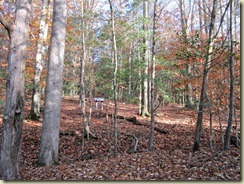 These woods have changed during the past 230 years. Even the lay of the land. Gullies, streams, slopes, cleared areas. Logging, farming, and just plain weather all have left their mark. We can only imagine how things looked to Loyalist troops encamped here in mid-August 1780. Indeed, according to some of the source material, we can’t even be sure of the camp’s exact location.
These woods have changed during the past 230 years. Even the lay of the land. Gullies, streams, slopes, cleared areas. Logging, farming, and just plain weather all have left their mark. We can only imagine how things looked to Loyalist troops encamped here in mid-August 1780. Indeed, according to some of the source material, we can’t even be sure of the camp’s exact location.
 It’s likely, as the photo from the Park’s informational sign above suggests, that Loyalists relied primarily on tents for shelter. This was a temporary encampment, after all. And troops had to carry whatever they used on their backs. During August in this part of South Carolina there would have been little need for shelter beyond the occasional rainfall. Tents would have made good sense.
It’s likely, as the photo from the Park’s informational sign above suggests, that Loyalists relied primarily on tents for shelter. This was a temporary encampment, after all. And troops had to carry whatever they used on their backs. During August in this part of South Carolina there would have been little need for shelter beyond the occasional rainfall. Tents would have made good sense.
 Down toward the River, be sure to stop at the Mary Musgrove Monument. Mary Musgrove, like Issaqueena, the American Indian woman of Issaqueena Falls fame, [click link for more information] is a historic figure we remember largely through her appearance in a nineteenth century novel.
Down toward the River, be sure to stop at the Mary Musgrove Monument. Mary Musgrove, like Issaqueena, the American Indian woman of Issaqueena Falls fame, [click link for more information] is a historic figure we remember largely through her appearance in a nineteenth century novel.
In Mary Musgrove’s case, it was Joseph Pendleton Kennedy’s “Horse-shoe Robinson.” She also sometimes is confused with an earlier eighteenth century Mary Musgrove, the daughter of a Creek Indian Mother and Charleston merchant father. A woman noted for facilitating communication between American Indians and Northern European immigrants in Georgia.
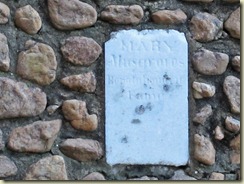 The legend of Musgrove Mill’s Mary, nevertheless, was adequate to inspire erection of this monument early in the last century. Whatever Mary Musgrove’s personal role in the War effort, she and other women contributed significantly to the ultimate Patriot victory. So, as the Park informational sign suggests, “Her legend does, however, stand as a tribute to the countless women who served as spies, messengers and even combatants during America's fight for Independence.”
The legend of Musgrove Mill’s Mary, nevertheless, was adequate to inspire erection of this monument early in the last century. Whatever Mary Musgrove’s personal role in the War effort, she and other women contributed significantly to the ultimate Patriot victory. So, as the Park informational sign suggests, “Her legend does, however, stand as a tribute to the countless women who served as spies, messengers and even combatants during America's fight for Independence.”
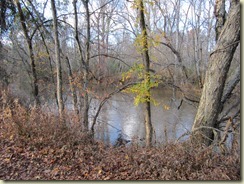 From the Mary Musgrove Monument, continue across the cleared field toward the river. Somewhere along here is the location of the north-south wagon road’s ford.
From the Mary Musgrove Monument, continue across the cleared field toward the river. Somewhere along here is the location of the north-south wagon road’s ford.
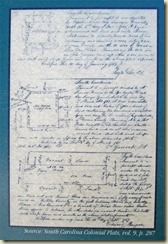 We don’t know its exact location. But according to period maps, it has to have been along here somewhere. Indeed, we’re not even sure of the exact path of the wagon road that played such an important role in the Battle of Musgrove Mill. Somewhere not far from here, though, Loyalist troops must have looked out on the morning of August 19th to see Captain Inman and his band of Patriot Volunteers ride across the ford shooting. Only to appear to lose their nerve, turn tail, and flee back they way they came. Their relief was short lived.
We don’t know its exact location. But according to period maps, it has to have been along here somewhere. Indeed, we’re not even sure of the exact path of the wagon road that played such an important role in the Battle of Musgrove Mill. Somewhere not far from here, though, Loyalist troops must have looked out on the morning of August 19th to see Captain Inman and his band of Patriot Volunteers ride across the ford shooting. Only to appear to lose their nerve, turn tail, and flee back they way they came. Their relief was short lived.
 From here the trail follows the bank of the Enoree west, toward the site of the Musgrove Mill itself. This is a fascinating walk, through the Enoree’s flood plain with its wildly-shaped trees, vines, and plant life.
From here the trail follows the bank of the Enoree west, toward the site of the Musgrove Mill itself. This is a fascinating walk, through the Enoree’s flood plain with its wildly-shaped trees, vines, and plant life.
 Archaeologists are more certain of the location of Edward Musgrove’s mill. If only because it was built and rebuilt in the same location until the early 20th century.
Archaeologists are more certain of the location of Edward Musgrove’s mill. If only because it was built and rebuilt in the same location until the early 20th century.
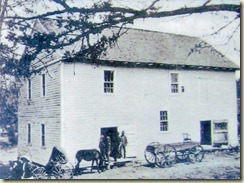 Here’s a 1908 photo of the last mill to occupy the site.
Here’s a 1908 photo of the last mill to occupy the site.
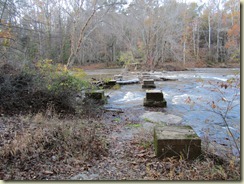 Don’t be fooled by the ruins of the bridge just above the site of the mill. As I was during my first visit! This is what remains of a much later span, washed away long ago by the Enoree at flood, and never replaced.
Don’t be fooled by the ruins of the bridge just above the site of the mill. As I was during my first visit! This is what remains of a much later span, washed away long ago by the Enoree at flood, and never replaced.
 From here the trail loops back up behind the Visitors Center, past an inviting fishing pond, and then back to the parking lot.
From here the trail loops back up behind the Visitors Center, past an inviting fishing pond, and then back to the parking lot.
 Before you leave be sure to inspect the ruins of what is thought to be the foundation of Edward Musgrove’s house. Burned, then rebuilt, according to one of his descendants, by the Loyalists in spite of his earlier generosity at the time of the Battle. Neutrality sometimes isn’t enough, it seems.
Before you leave be sure to inspect the ruins of what is thought to be the foundation of Edward Musgrove’s house. Burned, then rebuilt, according to one of his descendants, by the Loyalists in spite of his earlier generosity at the time of the Battle. Neutrality sometimes isn’t enough, it seems.
Stay tuned, since next we’ll visit the north section of the Park to walk the trail through the battlefield.

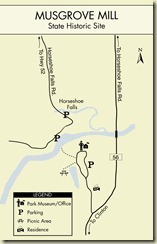





No comments:
Post a Comment